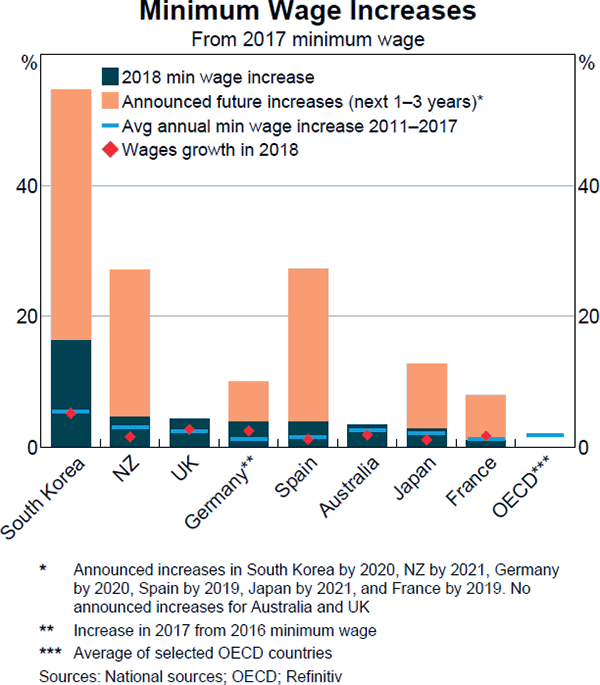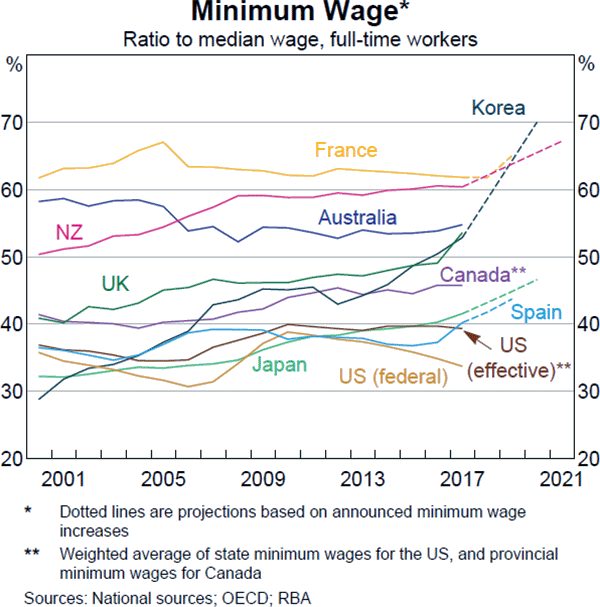Statement on Monetary Policy – February 2019 Box A: Minimum Wage Developments in Advanced Economies
Minimum wages were increased substantially in 2018 in several advanced economies, in many cases to fulfil election commitments to reduce inequality. These increases were larger than average minimum wage increases of recent years and aggregate wages growth in 2018 (Graph A1). In Korea, the minimum wage was increased by 16 per cent in 2018, and a further increase of about 30 per cent is planned over coming years. In Spain, the minimum wage was increased by 22 per cent in early 2019, while New Zealand is planning a 21 per cent increase by 2021. Japan's planned minimum wage increases are smaller, but are large relative to Japanese inflation and aggregate wages growth over the past couple of years. The French government announced an 8 per cent increase in the minimum wage in 2019 following public protests. Germany, where a national minimum wage was introduced only in 2015, plans to increase it in line with the strong growth in aggregate wages over recent years. Some Canadian provinces, such as Alberta and British Columbia, implemented substantial minimum wage increases in 2018.
These recent increases have boosted the ratio of minimum to median wages in many advanced economies (Graph A2). In Korea, this ratio has risen steeply since 2000. The Korean government is targeting a ratio of 70 per cent by 2020, which is likely to be the highest among the advanced economies. The United States is a notable exception to this trend: the national ratio is declining there because the federal minimum wage has been unchanged since 2009. However, over half of US states have state-based minimum wages that are above the federal minimum and these have increased in recent years. As a result, the effective US minimum wage has kept pace with the median wage over the past decade. In 2018, 18 states increased their minimum wage and a number of states plan substantial increases in coming years.[1] There have also been some high-profile ‘internal minimum wage’ increases by US companies in recent years, including Amazon and Walmart.


Minimum wage increases could push up aggregate wages growth and increase inflationary pressures, depending on how employment and hours worked are affected. Economic theory does not make strong predictions about the effect on employment but the response is likely to depend on the size of the increase and the share of the workforce who is affected. This could include workers who earn slightly above the minimum wage. Historical experience, which is mainly of small, incremental increases in the minimum wage, suggests little to no effect. However, there is less prior experience of larger increases similar to those seen recently, so it is possible that the effects on employment could be more negative for these recent cases.
A relatively high share of the Korean workforce, around 20 per cent, earns the minimum wage. As a result, aggregate Korean wages growth doubled to nearly 5½ per cent following the substantial 2018 minimum wage increase, and employment growth slowed sharply. It is likely that the negative effect on employment was strong because a large share of the Korean workforce is on temporary contracts and earning the minimum wage, and these workers are quite easy to fire. There appears to have been little impact on inflation so far, although the Bank of Korea has identified the minimum wage increase as an upside risk to its inflation outlook. It is possible that the sustained increases in Korea's minimum wage over the next few years could eventually lead to a pick-up in inflation.
In most other advanced economies the effects are likely to be smaller because the minimum wage increases are smaller. For example, in Japan, the share of workers on the minimum wage is only about half of that in Korea and minimum wage increases have been comparatively modest. So far, employment growth does not seem to have been affected; strong growth in underlying demand for labour could be offsetting effects that might otherwise occur. The effect of minimum wage increases may be more discernible in Spain and in New Zealand, where the increases, just implemented or planned, are substantial. The Reserve Bank of New Zealand, however, expects that the higher wage costs will mostly be absorbed in firms' margins and therefore not affect inflation much.
In Australia, only around 2 per cent of workers are on the national minimum wage, but around 20 per cent of employees are on industry- and skill-specific minimum wages (award wages), which are set in a similar way to the national minimum wage. To date, Australian minimum wage increases have tended to be small and incremental, and have not adversely affected employment via hours worked or job losses.[2]
Footnotes
Most notably, the minimum wage is set to increase by about 40 per cent by 2022 in California, which is the largest US state accounting for about 12 per cent of US employment. Other states with planned large minimum wage increases are Michigan, Oregon and New York. [1]
See RBA (2017), ‘Box C: Minimum Wage Decision’, Statement on Monetary Policy, August, pp 42–43; and Bishop (2018), ‘The Effect of Minimum Wage Increases on Wages, Hours Worked and Job Loss’, RBA Bulletin, September, viewed 10 January 2019. Available at <https://www.rba.gov.au/publications/bulletin/2018/sep/the-effect-of-minimum-wage-increases-on-wages-hours-worked-and-job-loss.html>. [2]